Are Factory Farms Good For The Animal Factory Farms Are Good For The Animal
Factory farms are starting to get more than visibility in the mainstream media. And the reasons are far from positive.
Information technology is condign common cognition that factory farms are horrific places where animals aren't treated equally living, sentient beings only as products and pieces of the industrial food machine.
With more documentaries becoming pop on Netflix, more than people are seeing the truth.
The truth is that factory farming is an abomination and needs to stop.
Even people who eat meat believe that factory farms and their practices are not merely bad for the animals but for the environment equally well.
What are Factory Farms?
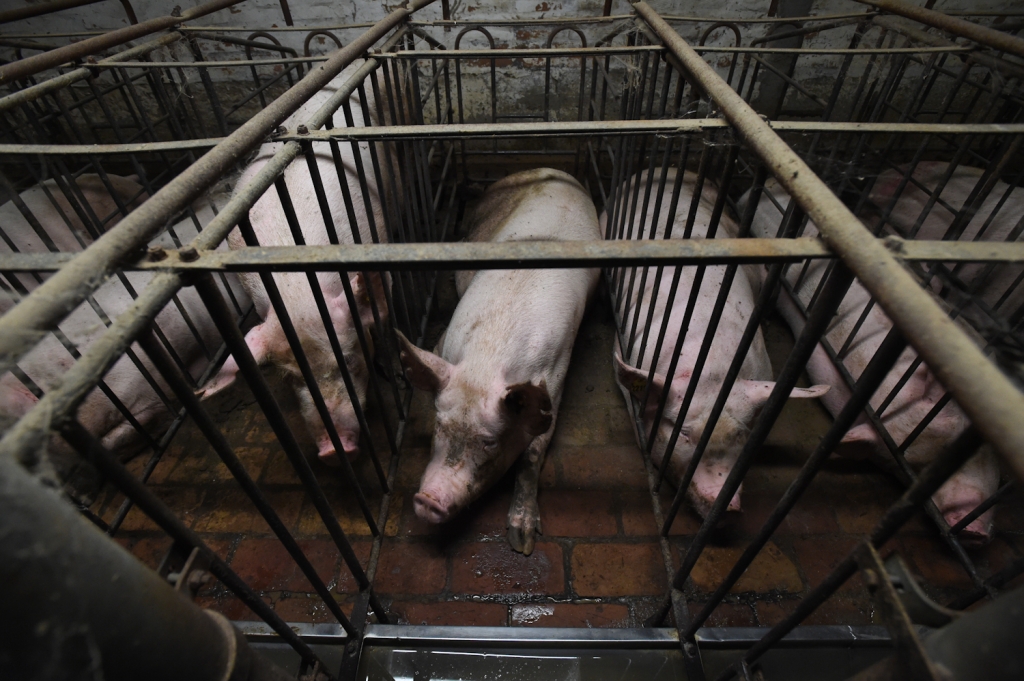
Factory farms are substantially industrial beast factories that brood and enhance animals for human consumption.
There are many types of manufacturing plant farms out there and we'll get to those shortly. Still, at that place is a common pattern across all types of manufactory farms: they are built specifically to be as efficient as possible. Essentially, they are factories that produce the raw materials for many different products that are developed in the next round of factories.
But in this instance, the raw materials are live animals and the second round of factories where the different products are created from the raw materials are slaughterhouses.
The meat industry knows that people don't agree with how factory farms operate so they are hidden from the public eye.
In fact, the industrial nutrient complex is and so aware of the public's distaste for factory farming the food lobbyists influence lawmakers to create ag-gag laws in order to punish the people looking to expose the horrors behind the barbed-wire fences of factory farms.
What Are Ag-Gag Laws?
Ag-gag laws are designed specifically to protect large corporations in the food industry.
Because food executives in the meat, dairy, and egg industries know that the full general public would be horrified by what happens at their farms, ag-gag laws have been used to try to silence whistleblowers and animal rights activists that go underground to expose brute abuse on manufacturing plant farms.
Ag-gag laws are dangerous because they essentially give farmers and those behind the food manufacture a gratuitous pass at doing what they want to animals. These laws are designed to scare off activists or potential whistleblowers from taking videos, photos, or documenting in any mode what happens on factory farms.
While the depth and consequences of ag-gag laws vary from land to country, at that place are places in the Usa where activists or whistleblowers tin can exist charged as terrorists and imprisoned for years for uncomplicated exposing violent crimes and abuse happening on farms.
Prohibiting people from seeing what is happening on a subcontract, or any business for that matter makes it impossible to hold people accountable for their deportment.
And when those actions involve the breeding and raising of countless sentient beings, it is even more than important to have accountability so atrocities don't occur behind closed doors.
Types of Factory Farms
Factory farms come in all shapes and sizes and tend to different industries birthday.
While in that location might be some differences here and there, the chief things connecting all of these farms is the cruelty and suffering that the animals face while living a confined life awaiting imminent slaughter.
Another thing that makes these farms, regardless of what kind of animal is being raised, so similar, is how their primary goal is efficiency. Merely like a factory automated with gadgets and robots to speed upward the production rate, factory farms employ similar tactics.
And finally, another commonality that factory farms all take is the fact that they are harming animals, the surroundings, and people at amazing rates and depths.
Factory Farmed Cows for Beef and Dairy
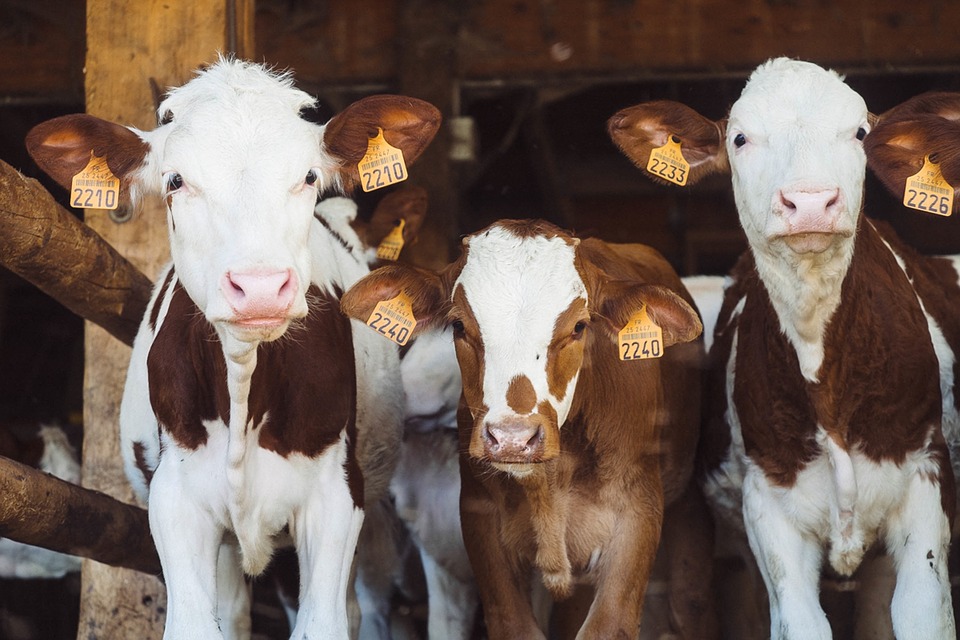
Factory farms that raise cows for beef and dairy are extremely detrimental to the environment and human health in communities surrounding the farms.
At any given moment, there are approximately 1.5 billion cows on farms around the world. These cows are used for both the dairy industry and the beef industry.
Raising cows consumes an unsustainable amount of h2o. Beyond water usage for the cow's drinking water, factory farms use high quantities of h2o for keeping facilities make clean. This doesn't even count the water that is necessary to grow the soy and corn that is fed unnaturally to cows around the world.
Other factors that counterbalance into the negative impact that dairy and beef farms take on the surroundings include the toxic dust kicked up from so many animals that spread beyond the farm into surrounding communities. Improper disposal of cow manure also plays a huge role in destroying local ecosystems, contaminating water, and ruining the soil.
Mill Farmed Pigs
There are just under one billion pigs existence raised for food at whatever given moment around the globe.
A vast majority, 97 out of 100 of the pigs beingness raised in the Usa are on manufactory farms.
Pig farms are unusually cruel to the animals beingness raised for slaughter.
Many common practices found beyond pig farms are barbarian. Tail docking and tooth clipping happen and the farmers claim it's to help the pigs. Many pigs in horrid conditions and squalor tin act out due to stress and anxiety. Farmers believe that past physically modifying their pigs they are keeping them safe. In reality, they simply do this to preclude the spread of disease. Pigs can become so stressed out that they'll bite each other'due south tails and feet and even resort to cannibalism. These behaviors do not occur in nature.
Many female pigs spend their lives on their sides in gestation crates, a barbaric way of keeping them stationary prisoners throughout their repeated pregnancies.
Correct before giving nascency, they are moved to farrowing crates. This is even worse than the gestational crate. The babe is taken abroad almost immediately to exist raised for meat or to take the same path as its mother. It depends on sex.
One week later, the mother is forcefully impregnated and is back in the gestational crate. This process goes until she is no longer able to accept babies and is slaughtered for her meat.
Manufactory Farmed Chickens
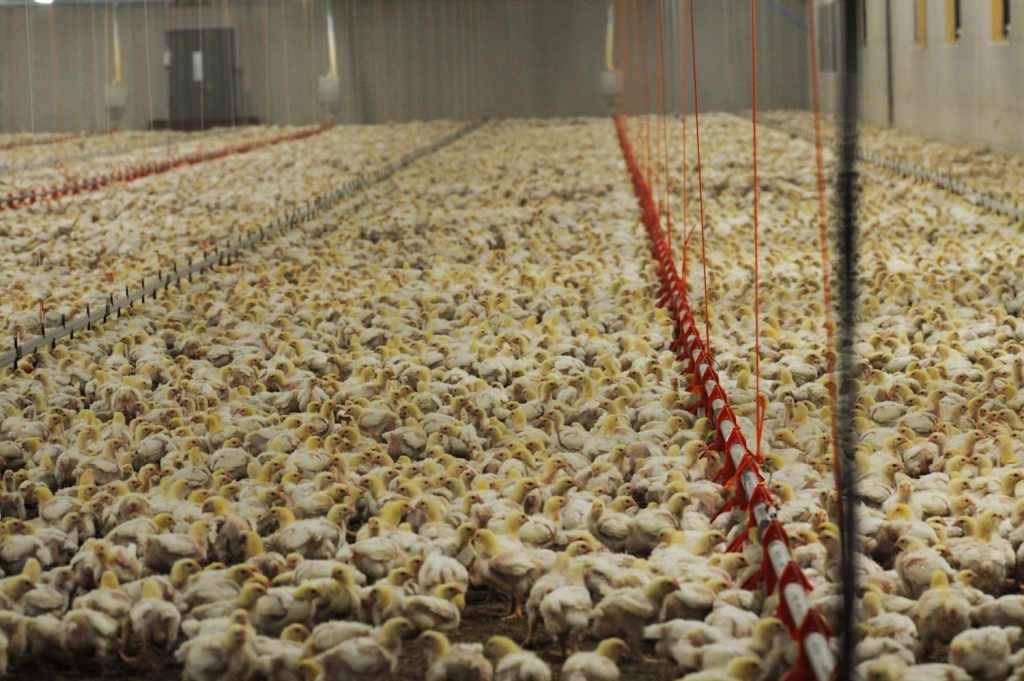
Industrial poultry farms can heighten and house shockingly high numbers of birds.
This is the case for both broiler and layer hens.
Broiler hens are the chickens raised for their meat.
In the US alone, nearly 9 billion chickens are killed for their meat every unmarried year. And in 2018, 109 million eggs were produced just in the US.
To make these numbers even more than shocking, approximately 99.9% of those broiler chickens and 98.2% of layer hens are raised on factory farms.
Like cows and pigs, chickens endure for like reasons on factory farms. Overcrowding, poor and unnatural diet, exposure to disease, and high levels of stress brand life on a mill farm a nightmare for chickens.
When it comes to health concerns, it isn't only the craven we demand to worry about.
We reported at the end of 2018 a story virtually residents in Maryland suffering from toxic air acquired past poultry farms.
Residents of Somerset and Wicomico Counties suffer from extraordinarily high rates of asthma, lung cancer, and chronic pulmonary obstructive disease
Chickens most obsessively scratch at the ground. This kicks up high quantities of grit. Because there are so many chickens on factory farms and cleanliness costs time and resources farmers don't desire to invest in, the manure mixes in with the grit.
This turns into highly toxic air that spreads well across the farm and into neighboring communities.
Other Types of Manufacturing plant Farms
There are many other types of factory farms that are sprouting upward effectually the earth to meet growing populations and demand.
Fish farming is becoming more popular as environmentalists push against ocean trawling and the damage the fishing industry has done to marine life.
However, fish farming hurts the oceans as well. In fact, fish farming is bad for local ecosystems and waterways anywhere near fish production. Chemicals and antibiotics from fish feed can cause major damage to native wild fauna.
Other types of factory farms include turkeys, sheep, goats, frogs, rabbits, and many more. They are bred and raised for their meat, skin, fur, milk, and eggs. The similarities across all of them show the same patterns of inhumane conditions and treatment of animals.
Why are Manufacturing plant Farms Bad for Animals?
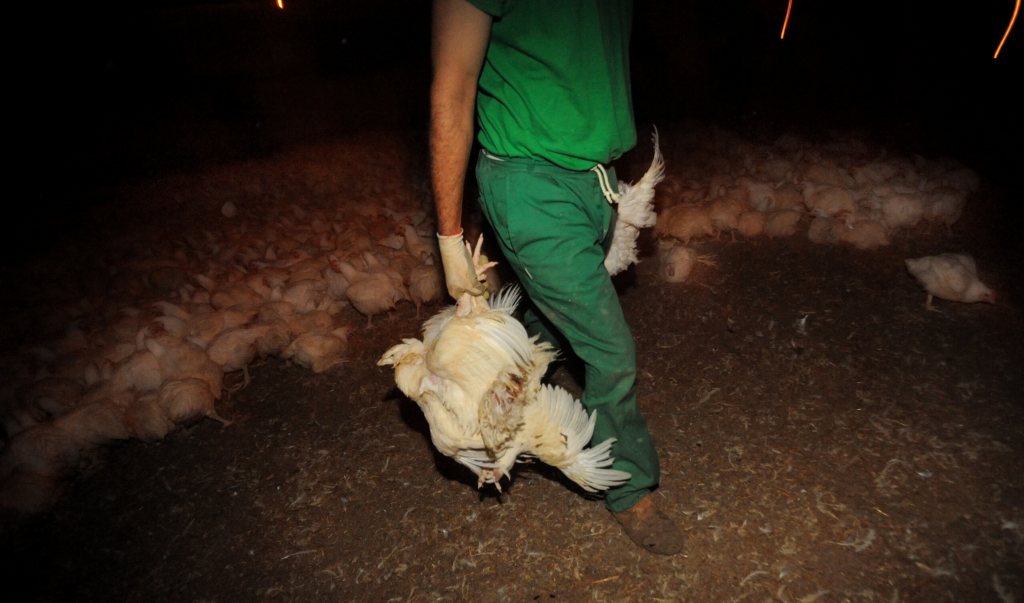
Factory farms are bad for animals because it makes it so they can't alive a natural life.
Animals born and raised on factory farms don't know what it is similar to be gratuitous. They are bred into a lifetime of extreme solitude and suffering.
Animals feel stress, anxiety, and fear like humans. Existence contained, often times in spaces then pocket-size they can't movement does a number on the mental health of the countless animals that live their brusque lives on factory farms.
Breeding Animals into Being Then They Can Exist Killed
The animals on these farms exist for one reason and one reason just. They are bred to be killed.
Animals on factory farms don't know what it is like to be free. These animals don't know comfort. They aren't immune to feel family and friends every bit they do in nature.
They experience fright, suffering, and farthermost discomfort earlier beingness packed into trucks and taken to slaughterhouses.
To the companies and farmers responsible for their survival, they are zippo more than than pegs in the motorcar. They are far from sentient beings deserving of a life gratuitous from fear.
What Percent of Meat Comes from Factory Farms?
According to a global study conducted past the Sentience Institute, the percentages of animals raised on manufacturing plant farms is alarming.
In the United States, the numbers are broken downward every bit the following:
- Broiler chickens (99.ix%) live on factory farms
- Turkeys (99.eight%) live on factory farms
- Egg chickens (98.two%) live on manufacturing plant farms
- Pigs (98.3%) alive on manufacturing plant farms
- Cows (70.4%) live on mill farms
Those are frightening numbers.
Many people who swallow meat like to say they only buy "humane meat." First off, humane meat doesn't actually be. Humane meat is a marketing tactic to brand people recollect that the animals they are eating didn't endure. They did.
Simply fifty-fifty if people want to truly believe they are buying humanely killed animals (once again, something that isn't existent), the chances of finding them would be a smashing claiming considering almost all meat comes from manufacturing plant farms.
In that location is no chance of "humane" meat to come from a manufacturing plant subcontract.
The History of Factory Farms
So when did factory farms first appear in history?
The first factory-farmed creature was the chicken and that started in the US dorsum in the 1920s.
For decades, it was only the craven that was brought indoors into what today would be considered a CAFO. They were bred year round for their eggs and meat.
It wasn't until the 1960s that factory farming similar we know today came into the pic. One of the main arguments early (and to this twenty-four hour period for marketing purposes) is that factory farming exists to encounter the growing global demand for animal products.
And while this sounds like it could make sense because of a growing population, the only reason people requite this kind of justification the fourth dimension of day is because of the misguided and unsafe thought that humans need to swallow animals.
Many people will argue that factory farming animals is necessary for human survival. They will say that there aren't enough plant-based foods to feed the world'south growing population. That simply isn't true.
An Inconvenient Truth Virtually the World'southward Crops
In fact, only 55% of the world'due south cropland actually goes to feed humans. That leaves a whopping 45% of all crops grown on the planet that doesn't go to humans. That is a substantial amount of food that people aren't eating. Where does it go? 36% of that is fed to animals on factory farms.
Factory farming was creating to create the amount of meat necessary to come across the demand of a growing population. If grown on a rolling pasture the style many people think of brute farming (because of marketing and labels), the global meat supply would be much more expensive.
Factory farms allow farmers to grow huge numbers of animals quickly and without taking into business relationship the well-being of those animals.
Because of this, they are able to produce meat at extraordinarily depression prices. This meat turns into processed meats that then perpetuate the growing popularity of the Western Diet.
This diet increases people'due south hazard of becoming obese or suffering from many preventable diseases similar diabetes, heart disease, and certain types of cancer.
What Happens on Factory Farms?
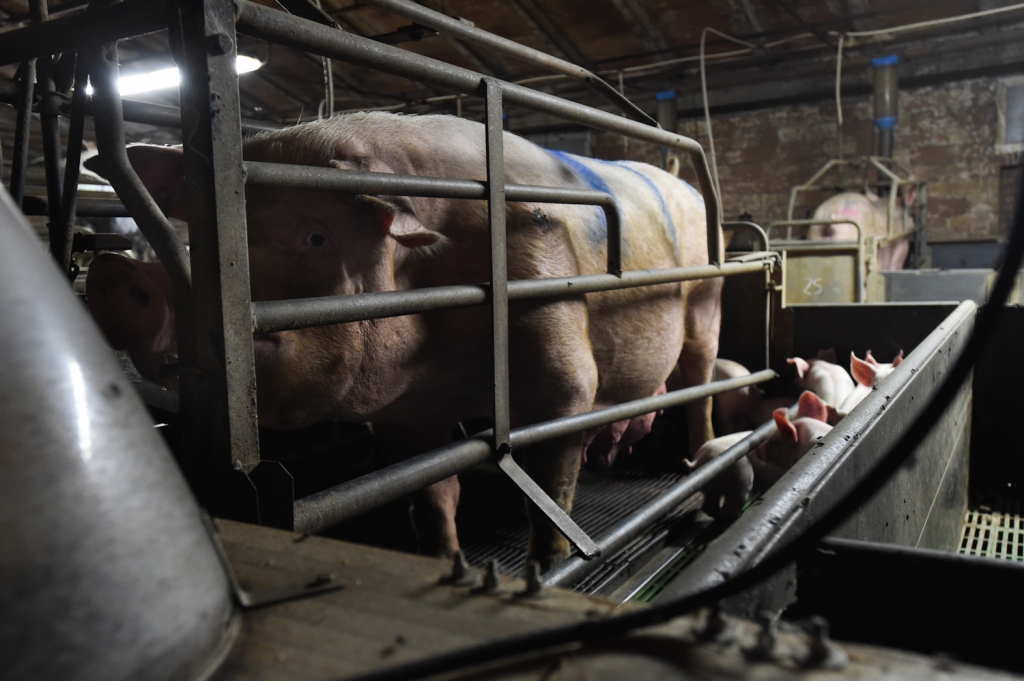
Mill farms breed animals into existence for the sole purpose of killing them.
While live, they endure unthinkable suffering, discomfort, stress, and fear. They are confined to over-populated living quarters, coexistence with highly irritable and stressed out animals, and, many times, abusive farmers and handlers.
The wheel of hardship and suffering on factory farms is very real and well documented. It is a systemic trouble that is born out of the very nature of the factory-like mindset and attitude imposed by large corporations seeking high efficiency and profitability.
In order to produce the numbers necessary to meet the demands of the corporations that contract the farms, mill farmers are only unable to provide their animals with anything that remotely resembles a humane living state of affairs or life.
Inhumane Treatment and Suffering of Animals on Factory Farms
There are countless videos and photos obtained by activists and farm workers turned whistleblowers that display the cruelty imposed on factory-farmed animals.
Many of these images are also difficult for people to watch. Many people, specially people who eat animals, simply ignore these images.
Films similar Dominion and Earthlings are extremely difficult to spotter but accept one thing in mutual: The images in the films testify the norm, not the exception. These images of suffering happen across all manufacturing plant farms, not just a few bad apples.
When animals are seen and treated equally products and not sentient beings, inhumane treatment is unavoidable.
Factory farmers piece of work nether immense force per unit area from the companies that hire them to produce every bit much meat as possible that they are simply unable to view their animals as animals.
Because of this, a disconnect sets in and the perpetual wheel of inhumane treatment (and the subsequent suffering of animals) becomes standard.
Terrible Living Condition for Animals on Factory Farms
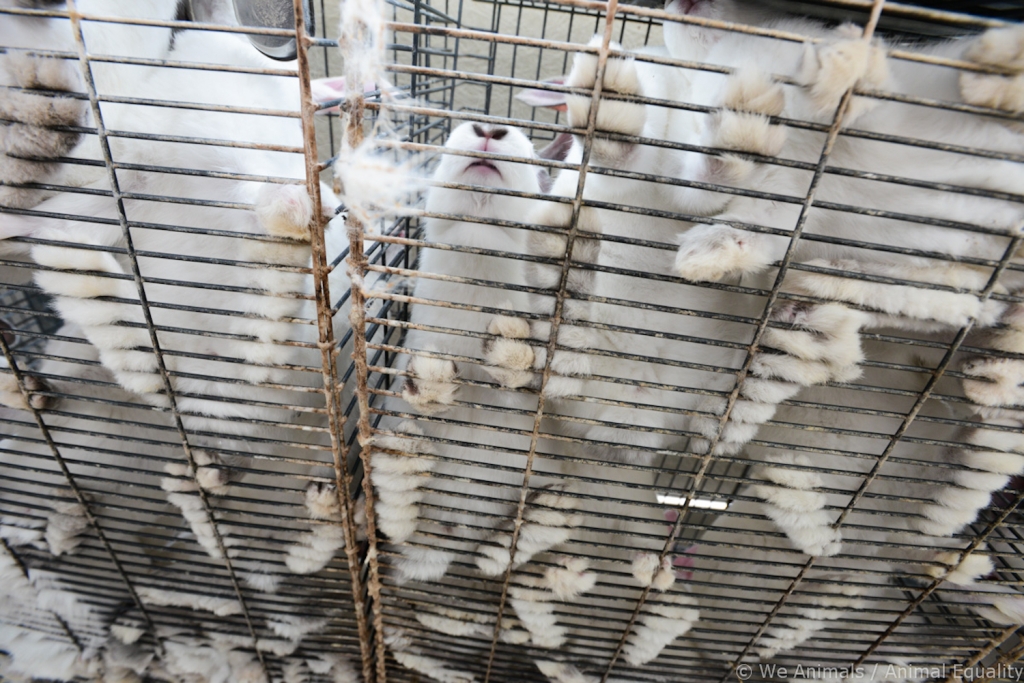
And because of this high demand from corporations that contract factory farms, the cardinal to keeping contracts is efficiency. The more efficient the farm, the more than assisting it is for the visitor selling the meat.
The more animals on the farm, the more profitable the business. If manufacturing plant farmers practice as little as possible for the well-being of the animals without them getting sick or dying in the process, they have found a highly efficient and profitable model.
This is at the direct expense of the animals. It makes it and then they take no quality of life any and are unable to have any kind of resemblance of what a natural life would be for them in nature.
Animals on manufactory farms accept been observed to suffer from severe stress and depression because of the weather they are forced to live in.
Annihilation slightly resembling a natural lifestyle for these animals or whatsoever kind of quality of life cease to exist on factory farms.
Conclusion
Manufactory farms will one day be looked dorsum on as a nighttime and barbarian practice.
People are becoming more and more enlightened of what happens on these farms and plant-based alternatives to meat are growing at incredible rates.
Many people who eat meat are eating less and consuming more institute-based meats similar the Beyond Burger or Incommunicable Burger.
More than and more mainstream restaurants and grocery stores are stocking their shelves and menus with these plant-based alternatives and their popularity is soaring.
Clean meat is close to condign a reality and volition provide meat eaters with an identical culinary experience equally meat without animal farming being a part of the process.
While a vegan earth seems may seem like a afar future, a world where manufactory farming is acceptable may come to an stop in the near hereafter.
This would save the lives of billions of sentient beings, help reduce pollution and climate change significantly and provide people with much healthier and more ethical alternatives to their diets.
Source: https://sentientmedia.org/factory-farms/
Posted by: labordebuirl1989.blogspot.com

0 Response to "Are Factory Farms Good For The Animal Factory Farms Are Good For The Animal"
Post a Comment